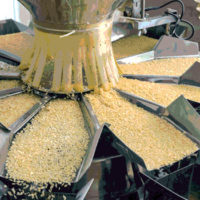Advances in the Application of Food-grade Lubricants

With the increasing interest on the part of food manufacturers to apply sanitary equipment design principles to their processes, many food processing equipment manufacturers are now designing and constructing equipment with food safety goals in mind. Some of these changes include making food processing equipment that is easier to disassemble for improved cleaning and sanitation; designing equipment that uses construction materials that are compatible with the facility’s environment, the product produced and the cleaning and sanitizing agents and methods used; and developing equipment that is compatible with other plant systems, such as electrical, hydraulic, steam, water and oil filtration systems.
These advances in sanitary equipment design arise from the food industry’s need to reduce and eliminate microbiological, chemical and physical contaminants in the plant environment. One area that is gaining increased attention is the application of food-grade lubricants as a part of sanitary equipment design considerations. All food and beverage processing equipment needs lubrication and should have adequate design to minimize lubricant contamination during processing. However, in actuality, the potential of incidental food contact cannot be completely negated. As such, it is critical that food-grade lubricants are used on all types of processing equipment to ensure public health protection. Of course, the use of food-grade lubricants supports the quality assurance/quality control (QA/QC) processes throughout the meat, poultry, fruit, vegetable and other food processing industries, and works as insurance against plant shutdowns.
It has been five years since NSF International launched its voluntary Nonfood Compounds Registration Program to re-introduce the previous U.S. Department of Agriculture (USDA) authorization program, which was terminated in 1998 (www.nsf.org/usda). NSF International, an independent, not-for-profit certification organization based in Ann Arbor, MI, essentially filled the gap created by the USDA by continuing the central compound authorization and listing system, while strengthening the program with new features and developing future directions under NSF’s global initiatives with a focus on food-grade lubricants. At present, there are a number of types of registration categories of interest to food-grade lubricant manufacturers, food processors and regulators.
Lubricant Registration Categories
The applicable NSF food-grade lubricant registration categories include:
H1 Registration: Food-grade Lubricants. The U.S. Code of Federal Regulations Title 21 (21 CFR) Food and Drugs established formulation requirements for incidental food contact (food-grade) lubricants. An incidental food contact lubricant must be formulated using the ingredients listed under 21 CFR Section 178.3570, which also references Generally Recognized As Safe (GRAS) substances listed under parts 182 and 184. Based on this regulation, the USDA developed its own incidental contact lubricants category (H1) and listed authorized H1 lubricants until 1998. After 1998, the USDA H1 guideline became part of the NSF Registration Guidelines (Section 5.9.1).1 The USDA staff periodically reviews the NSF Registration Guidelines and their comments are included in updated versions. To date, NSF has independently registered nearly 2,000 H1 lubricants. These include lubricants, hydraulic oils and greases used in equipment for cleaning, sanitizing, canning, bottling, blending, chilling, frying cutting, slicing and peeling, as well as pumps, mixers, tanks, hoses, chain drives and conveyor belts.
HX-1 Registration: Food-grade Lubri-cant Components/Ingredients. The previous USDA program reviewed but did not publish the listing for partial products, such as base oils and additive packages for formulating food-grade lubricants. NSF introduced a new registration category (HX-1) to provide a source where formulators of finished products can select independently registered food-grade lubricant components. The registration also provides ingredient suppliers with the benefit of establishing product confidence without disclosing confidential formulations. Both H1 and HX-1 formulations must meet the 21 CFR requirements mentioned. Any new ingredients intended for H1 lubricants that are not listed in 21 CFR must be evaluated separately through appropriate risk assessment procedures.
In addition to being listed in 21 CFR, there are other options that will establish that an ingredient is appropriate for use as an H1 lubricant. For example, an ingredient could be a base oil or lubricant additive that is added to enhance equipment life or product performance. NSF provides a risk assessment service to establish ingredient compliance to U.S. Food and Drug Administration (FDA) regulations by FDA Letter of Opinion (LOO), Affirmation of GRAS, Threshold of Regulation (TOR), or Food Contact Notification (FCN). The risk assessment process typically involves data generation/collection, data review, submission strategy development and submission for FDA review. Expected timeline for risk assessment could vary from six months to four years, depending on the availability of data.
Antimicrobial Food-grade Lubricants. The food industry has long expressed concerns regarding bacterial growth in lubricated parts of food processing equipment that may have incidental food contact. The potential of H1 lubricants containing biocides has been proposed. However, its practicality has been hindered by dual regulatory hurdles: a biocidal ingredient used in a food-grade lubricant marketed in the U.S. must (1) be registered by the U.S. Environmental Protection Agency (EPA); and (2) comply with FDA regulations via prior sanction, GRAS affirmation, FCN or LOO.
HT-1 Registration: Incidental Food Contact Heat Transfer Fluids. Under the prior USDA program, all heat transfer fluids were listed under the P1 category (miscellaneous) covering diverse product types. Generally, USDA would provide a text in its authorization letter describing the approved end use. For example, the P1 letter for heat transfer fluids determined food contact allowance (e.g. incidental vs. nonfood contact).
Manufacturers of heat transfer fluids have recently expressed the need for developing a specific category code to determine food contact allowance, which will help end users identify them in listings and on labels. The NSF Nonfood Compounds Registration Program Steering Committee has been addressing this very issue. With advice from the USDA, the committee has recommended that NSF create new registration categories for incidental food contact heat transfer fluids (HT-1) and nonfood contact heat transfer fluids (HT-2). HT-1 formulations may comply with 21 CFR 178.3570 and other sections referenced therein and also with 21 CFR part 172. Products used in the immersion or spray of packaged meat and poultry must be composed of GRAS substances (21 CFR part 182 or 184) or substances complying with 21 CFR part 172.
H2 Registration: Non-food Contact Lubricants. Lubricants used by consumers and the non-food industry may still impact human health. Independent registration of non food-grade lubricants provides credible verification that the products are formulated with public health protection in mind. The previous USDA program developed the H2 guideline for non food-grade lubricants, which is now part of the NSF Registration Guidelines (Section 5.9.2). H2 lubricants are not intended for use in places where there is possibility of food contact. H2 formulations are not required to meet the 21 CFR requirements and most substances generally used in industry would be acceptable. However, the formulation must conform to Section 5.1 of the NSF Registration Guidelines for all nonfood compounds (i.e., no carcinogens, no mutagens, no teratogens, no mineral acids, no odorous substances, and no intentionally added heavy metals).
Developments and Proposals
On Oct. 21, 2003, the NSF Nonfood Compounds Registration Program Steer-ing Committee discussed an industry proposal to develop an optional certification scheme for food-grade lubricants. The current NSF H1 registration system, a re-introduction of the previous USDA H1 authorization program, verifies product formulations against 21 CFR and label accuracy. However, the system does not verify whether the products are being blended according to the registered formulations nor does it ensure adequate quality control processes are in place. The NSF Steering Committee recommended that a subcommittee group be created to discuss the feasibility, potential options and features of such a certification scheme, a task which is currently underway. The elements of the proposed scheme, how to certify and values to end users will likely be some of the primary topic of discussion at this subcommittee’s first meeting sometime as early as this spring. All interested parties are encouraged to participate in the group.
In addition, an ISO standard for incidental contact lubricants is currently under development. NSF participates on the ISO Technical Committee Work Group representing the U.S. NSF has requested to be the standards development organization to administer the U.S. adoption of the standard. The work group process could last several years. The main objective in this ISO initiative (driven mainly by international lubricants industries) is international harmonization: to have a single universal standard worldwide for food grade lubricants. The objective will be accomplished if all countries agree to accept the standard as a national standard. Historically, the international markets relied upon the U.S. regulations (i.e., the prior USDA program) and USDA H1 approval became the de facto international standard. NSF supports this ISO initiative and is prepared to offer certification against the ISO standard if it becomes available. In the meantime, NSF is actively developing collaborative relationships with international regulatory authorities to facilitate global marketing of food-grade lubricants. To date, the Australian Quarantine Inspection Agency has approved nearly 50 products and the Canadian Food Inspection Agency has introduced a fast-track review option for NSF-registered products.
The NSF Nonfood Com-pounds Registration Program is based on the previous USDA program and continues to reflect the current USDA policies on food safety. NSF has introduced new services such as the HT-1 incidental contact heat transfer fluids registration program and the HX-1 ingredient registration program in the last few years. NSF’s international initiatives are facilitating the process of global acceptance of food-grade lubricants. Stake-holders—food processors, lubricant manufacturers and regulators—are well placed to ensure public health protection through more effective application of food-grade lubricants used on all types of processing equipment.
Kenji Yano, Ph.D., is Program Manager of the NSF International Nonfood Compounds Registration Program, where he works with manufacturers, end-users of nonfood compounds and regulators with independent nonfood compounds registration services.
Looking for a reprint of this article?
From high-res PDFs to custom plaques, order your copy today!






